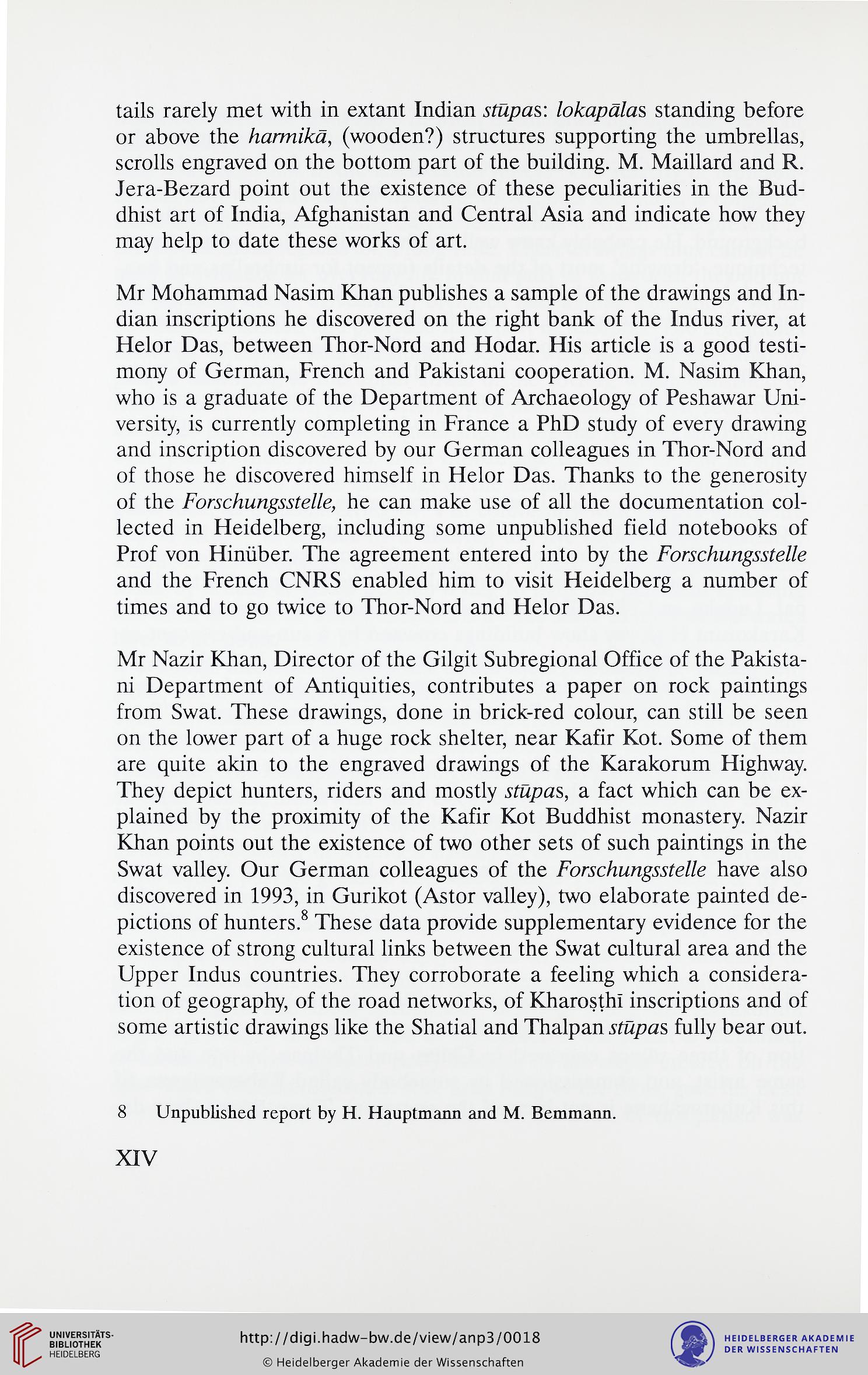tails rarely met with in extant Indian .stupas: /okapa/as standing before
or above the /iaf7?nka, (wooden?) structures supporting the umbrellas,
scrolls engraved on the bottom part of the building. M. Maillard and R.
Jera-Bezard point out the existence of these peculiarities in the Bud-
dhist art of India, Afghanistan and Central Asia and indicate how they
may help to date these works of art.
Mr Mohammad Nasim Khan publishes a sample of the drawings and In-
dian inscriptions he discovered on the right bank of the Indus river, at
Helor Das, between Thor-Nord and Hodar. His article is a good testi-
mony of German, French and Pakistani cooperation. M. Nasim Khan,
who is a graduate of the Department of Archaeology of Peshawar Uni-
versity, is currently completing in France a PhD study of every drawing
and inscription discovered by our German colleagues in Thor-Nord and
of those he discovered himself in Helor Das. Thanks to the generosity
of the he can make use of all the documentation col-
lected in Heidelberg, including some unpublished field notebooks of
Prof von Hinuber. The agreement entered into by the Fcrsc/mpgsVe//e
and the French CNRS enabled him to visit Heidelberg a number of
times and to go twice to Thor-Nord and Helor Das.
Mr Nazir Khan, Director of the Gilgit Subregional Office of the Pakista-
ni Department of Antiquities, contributes a paper on rock paintings
from Swat. These drawings, done in brick-red colour, can still be seen
on the lower part of a huge rock shelter, near Kafir Kot. Some of them
are quite akin to the engraved drawings of the Karakorum Highway.
They depict hunters, riders and mostly stupas, a fact which can be ex-
plained by the proximity of the Kafir Kot Buddhist monastery. Nazir
Khan points out the existence of two other sets of such paintings in the
Swat valley. Our German colleagues of the Fb/^c/tupgsVe/Ze have also
discovered in 1993, in Gurikot (Astor valley), two elaborate painted de-
pictions of hunters.^ These data provide supplementary evidence for the
existence of strong cultural links between the Swat cultural area and the
Upper Indus countries. They corroborate a feeling which a considera-
tion of geography, of the road networks, of Kharosthi inscriptions and of
some artistic drawings like the Shatial and Thalpan .stupas fully bear out.
8 Unpublished report by H. Hauptmann and M. Bemmann.
XIV
or above the /iaf7?nka, (wooden?) structures supporting the umbrellas,
scrolls engraved on the bottom part of the building. M. Maillard and R.
Jera-Bezard point out the existence of these peculiarities in the Bud-
dhist art of India, Afghanistan and Central Asia and indicate how they
may help to date these works of art.
Mr Mohammad Nasim Khan publishes a sample of the drawings and In-
dian inscriptions he discovered on the right bank of the Indus river, at
Helor Das, between Thor-Nord and Hodar. His article is a good testi-
mony of German, French and Pakistani cooperation. M. Nasim Khan,
who is a graduate of the Department of Archaeology of Peshawar Uni-
versity, is currently completing in France a PhD study of every drawing
and inscription discovered by our German colleagues in Thor-Nord and
of those he discovered himself in Helor Das. Thanks to the generosity
of the he can make use of all the documentation col-
lected in Heidelberg, including some unpublished field notebooks of
Prof von Hinuber. The agreement entered into by the Fcrsc/mpgsVe//e
and the French CNRS enabled him to visit Heidelberg a number of
times and to go twice to Thor-Nord and Helor Das.
Mr Nazir Khan, Director of the Gilgit Subregional Office of the Pakista-
ni Department of Antiquities, contributes a paper on rock paintings
from Swat. These drawings, done in brick-red colour, can still be seen
on the lower part of a huge rock shelter, near Kafir Kot. Some of them
are quite akin to the engraved drawings of the Karakorum Highway.
They depict hunters, riders and mostly stupas, a fact which can be ex-
plained by the proximity of the Kafir Kot Buddhist monastery. Nazir
Khan points out the existence of two other sets of such paintings in the
Swat valley. Our German colleagues of the Fb/^c/tupgsVe/Ze have also
discovered in 1993, in Gurikot (Astor valley), two elaborate painted de-
pictions of hunters.^ These data provide supplementary evidence for the
existence of strong cultural links between the Swat cultural area and the
Upper Indus countries. They corroborate a feeling which a considera-
tion of geography, of the road networks, of Kharosthi inscriptions and of
some artistic drawings like the Shatial and Thalpan .stupas fully bear out.
8 Unpublished report by H. Hauptmann and M. Bemmann.
XIV




